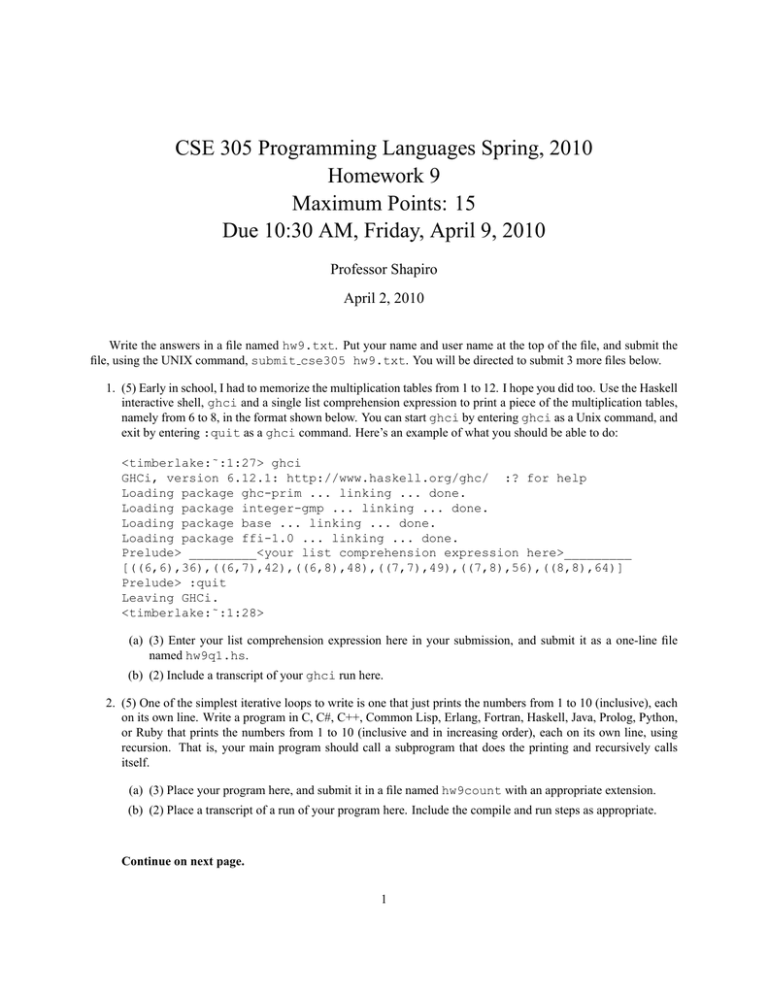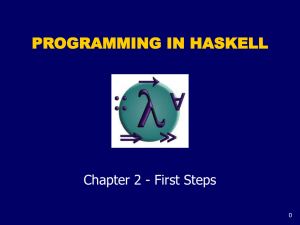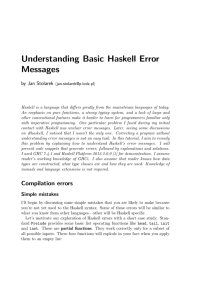CSE 305 Programming Languages Spring, 2010 Homework 9 Maximum Points: 15
advertisement

CSE 305 Programming Languages Spring, 2010 Homework 9 Maximum Points: 15 Due 10:30 AM, Friday, April 9, 2010 Professor Shapiro April 2, 2010 Write the answers in a file named hw9.txt. Put your name and user name at the top of the file, and submit the file, using the UNIX command, submit cse305 hw9.txt. You will be directed to submit 3 more files below. 1. (5) Early in school, I had to memorize the multiplication tables from 1 to 12. I hope you did too. Use the Haskell interactive shell, ghci and a single list comprehension expression to print a piece of the multiplication tables, namely from 6 to 8, in the format shown below. You can start ghci by entering ghci as a Unix command, and exit by entering :quit as a ghci command. Here’s an example of what you should be able to do: <timberlake:˜:1:27> ghci GHCi, version 6.12.1: http://www.haskell.org/ghc/ :? for help Loading package ghc-prim ... linking ... done. Loading package integer-gmp ... linking ... done. Loading package base ... linking ... done. Loading package ffi-1.0 ... linking ... done. Prelude> _________<your list comprehension expression here>_________ [((6,6),36),((6,7),42),((6,8),48),((7,7),49),((7,8),56),((8,8),64)] Prelude> :quit Leaving GHCi. <timberlake:˜:1:28> (a) (3) Enter your list comprehension expression here in your submission, and submit it as a one-line file named hw9q1.hs. (b) (2) Include a transcript of your ghci run here. 2. (5) One of the simplest iterative loops to write is one that just prints the numbers from 1 to 10 (inclusive), each on its own line. Write a program in C, C#, C++, Common Lisp, Erlang, Fortran, Haskell, Java, Prolog, Python, or Ruby that prints the numbers from 1 to 10 (inclusive and in increasing order), each on its own line, using recursion. That is, your main program should call a subprogram that does the printing and recursively calls itself. (a) (3) Place your program here, and submit it in a file named hw9count with an appropriate extension. (b) (2) Place a transcript of a run of your program here. Include the compile and run steps as appropriate. Continue on next page. 1 3. (5) In the Lecture Notes on Statement Level Control Structures, I have a recursive Common Lisp function named polishPrefixEval that evaluates an expression presented in Polish Prefix notation. Write a program in C, C#, C++, Common Lisp, Erlang, Fortran, Haskell, Java, Prolog, Python, or Ruby that uses iteration to evaluate an expression presented in Polish Prefix notation. Your main program should call a function named polishPrefixEval, which should use any iterative loop to evaluate the expression and return its value. The main program should clearly print the expression evaluated and the value returned by polishPrefixEval. Use the 3 examples used in the Lecture Notes, plus two more: (a) + * 2 3 4 which should evaluate to 10; (b) * + 2 3 4 which should evaluate to 20; (c) * 2 + 3 4 which should evaluate to 14; (d) / 20 - 8 3 which should evaluate to 4; (e) * 2 ** 3 4 which should cause some kind of error. I recomment representing the expression as a list whose successive elements are the elements of the expression, starting with the first. However, you may use any convenient sequential collection for this. You may use any convenient data type to represent the operators, +, -, *, and /. (a) (3) Place your program here, and submit it in a file named hw9prefix with an appropriate extension. (b) (2) Place a transcript of a run of your program here. Include the compile and run steps as appropriate. 2







